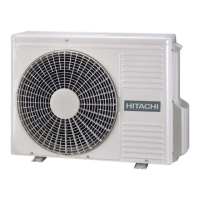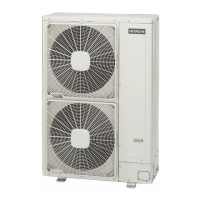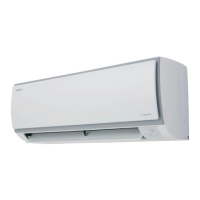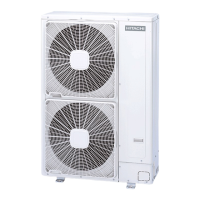3.2.2 Three principles on refrigerant piping work
In case of using refrigerant R410A in the refrigeration cycle, the refrigeration oil should be of a synthetic type one.
In order to avoid oxidation, pay much careful attention to basic piping work control to avoid infiltration of moisture or dust
during the refrigerant piping work.
Three principles Cause of failure Presumable failure Preventive action
1. Dry
Keep good dryness
• Water infiltration due to insufficient
protection at pipe ends
Icing inside tube at ex. valve
(Water choking)
Pipe protection
+ 1 Pinching
• Dewing inside of pipes
Generation of hydration and oxidation
of oil
2 Taping
↓ ↓
• Insufficient vacuum pumping time
Clogged strainer, etc., insulation failure
and compressor failure
Flushing
↓
Vacuum Drying
• One gram of water turns into gas
(approx. 1000 lrs) at 1 Torn
• Therefore, it takes long time to
vacuum-pump by a small vacuum
pump
2. Clean
No dust inside of pipes
• Infiltration of dust or other through
the pipe ends.
• Oxidation film during brazing
without blowing nitrogen.
• Insufficient flushing by nitrogen
after brazing
Clogging of expansion valve, capillary
tube and filter
Pipe Protection
→Oxidation of oil
1 Mounting Caps
→Compressor failure
2 Taping
↓
3 Pinching
Insufficient cooling or heating
compressor failure
↓
Flushing
3. No leakage
No leakage shall exist
• Brazing failure
Refrigerant shortage Careful Basic Brazing Work
→Performance decrease
↓
• Failed flaring work and insufficient
torque of squeezing flare
→Oxidation of oil
Basic Flaring Work
→Overheating of compressor
↓
• Insufficient torque of squeezing
flanges
↓
Basic Flange Connecting Work
Insufficient cooling or heating
compressor failure
↓
Air Tight Test
↓
Holding of Vacuum
3.2.3 Suspension of refrigerant piping
Suspend the refrigerant piping at certain points and prevent the refrigerant piping from touching weak parts of the building
such as walls, ceiling, etc. (If touched, abnormal noises may occur due to the vibration of the piping. Pay special attention
in case of short piping length).
A. Fire-proof section treatment.
B. Indoor unit.
In order to fix the piping to wall or ceilings use suspension and clamping systems as shown in the following figure.
3 Piping work and
refrigerant charge
54
SMGB0060 rev. 1- 12/2010

